CHOLLA (Opuntia species)
[Most
images are clickable, for a larger version]
Cholla cacti typically
have cylindrical stem segments, joined end-to-end in a
branching, tree-like manner. Growth stops at the end of
each season and is resumed by the production of new
branches in the following season. These plants are
closely related to the prickly pears (also Opuntia
species), which have large, flat pads.
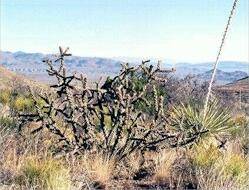
Tree cholla (Opuntia imbricata)
in upland desert grassland zone, South Texas
|
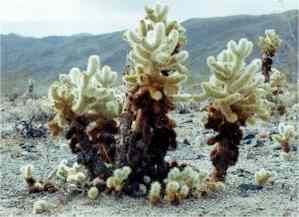
Teddy bear cholla (Opuntia
bigelovii) in Mojave Desert, California
|
There are
many cholla species in the warm deserts of North and
Central America, and many more which are frost-tolerant
and extend as far north as Canada and south to the
mountainous regions of South America. However, cholla
species are often difficult to tell apart, because they
can hybridise, leading to intermediate forms. In addition
to this, some species hardly breed at all, because their
seeds are sterile. In these cases the plants rely on
clonal propagation - stem segments fall to the ground and
take root, so that any local population of the plant
consists of genetically identical individuals, which
might differ slightly from another population of the same
species. The teddy bear cholla is a classic example of
this - see the right-hand image above.
Here we will cover the
common features of chollas, and illustrate the range of
variation by focusing on a few distinctive species,
including the tree cholla, teddy bear cholla, chain link
cholla, chainfruit cholla, diamond cholla, buckhorn
cholla and devil cholla. All these species differ in
their geographical ranges or in their temperature
tolerance, water requirements, soil preferences, etc.
One characteristic feature
of chollas is that the stem segments and branches are not
truly cylindrical but have raised areas called tubercles
on which the spine-bearing areoles are located. This is
most conspicuous in the chain link cholla (see the image
on the right below) because the pattern of the tubercles
gives a chain-link effect.
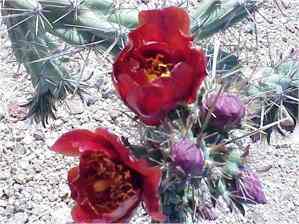
Typical cholla flowers
|
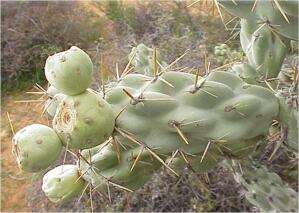
A stem segment and short
chain of fruits of the chain link cholla (Opuntia
cholla)
|
Also
charactersistic is the fact that most chollas have
brightly coloured flowers (with the typical cactus flower
structure) and are pollinated by bees. In most cases,
also, the fruits are fleshy and can be seen on the plants
for extended periods of the year. Sometimes the fruits
are brightly coloured, but in other cases they are green
and photosynthetic, persisting for year after year. One
example of this is the chain link cholla (see image
above) but the best example is the chainfruit cholla
(image further down this page), where long chains of
fruits accumulate year after year unless they are
dislodged. In fact, the fruits and stem segments of this
plant often are dislodged by passing animals of humans -
so easily that the other common name for this plant is
the "jumping cholla". The fruits are
usually sterile, and the plant reproduces when joints
fall to the ground and take root.
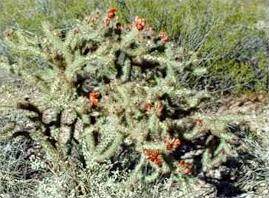
Buckhorn cholla (Opuntia
acanthocarpa)
|

Buckhorn cholla flowers
|
Another cholla - the
clavellina - has stem segments which are easily dislodged
and that are armed with very long spines. These readily
catch onto the fur of animals (or human clothing) or they
can spring up from the ground if an animal touches them
as it walks by. The Latin name of this plant - Opuntia
molesta - is aptly descriptive. It is an endemic
species of the Baja California peninsular of Mexico.
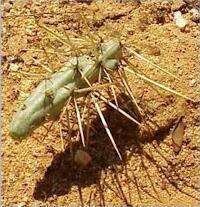
Dislodged stem segment of
clavellina (Opuntia molesta)
|
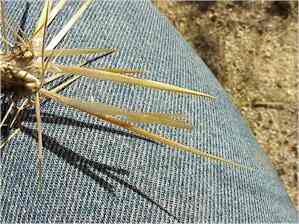
Close-up of clavellina
spines, showing the papery sheath (dislodged from
the lower spine)
|
Several of the most
heavily spined chollas can appear to be white in
sunlight. The reason is that the spines of most chollas
are covered with a papery sheath, which acts to reflect
sunlight and prevent the stems from excessive heating. As
would be expected, this is particularly true of the
species such as teddy bear cholla and chainfruit cholla
that grow in the hot, flat desert regions where the
exposure to sunlight is extreme. In the right-hand image
of clavellina (above) the papery sheath has been
dislodged from the lowermost long spine, but not from the
long spine above it.
Other branching chollas also have
sheathed spines, but the spines are not as dense. For
example, the diamond cholla (image below) has relatively
few, but long, spines which stick out almost at
right-angles from the stem. The yellow colour of these
spines is due to the colour of the sheath. A plant such
as this occurs in the cooler, higher elevations and has
less need to be protected from the sun's exposure.

Chainfruit or
"jumping"cholla (Opuntia fulgida)
|

Snow-capped diamond cholla (Opuntia
ramosissima) in the Upper Mojave Desert
|
One group of chollas - the club chollas
- differ markedly from the tree-like, branching chollas
discussed above. These are low-growing plants which often
form mats close to the ground and which branch from the
base rather than from the tops of the stems. Typical of
these plants is the devil cholla (Opuntia stanlyi
and related species) which can grow in arid sites where
the soil is saline or calcareous - a combination that few
other plants can tolerate. These club chollas are densely
covered in spines but the spines do not have sheaths.
Instead they have flattened spines, with dagger-sharp
tips that can penetrate shoes or animals, feet. When
these chollas become established in desert grasslands
they present a formidable barrier to grazing animals.
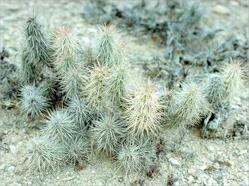
Devil cholla (Opuntia stanlyi)
|

A flowering club cholla |
All chollas have a woody
skeleton with a reticulate pattern (see image below),
quite different from the woody ribs of the taller
columnar cacti . The woody skeletons of some species,
such as the cane cholla, are often used to make canes or
other souvenirs.

Part of the skeleton of a dead
cholla stem, showing the reticulate pattern of the woody
support tissues.
The dense branches of living chollas
frequently are used as sites for nest-building by desert
birds such as the cactus wren and curve-billed thrasher.
The dead remains and fallen segments of chollas also are
used frequently by desert wood rats (Neotoma
species) for covering and protecting the entrances to
their nests.
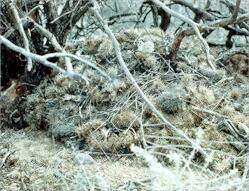
Large heap of cholla joints covering a
desert woodrat nest
|